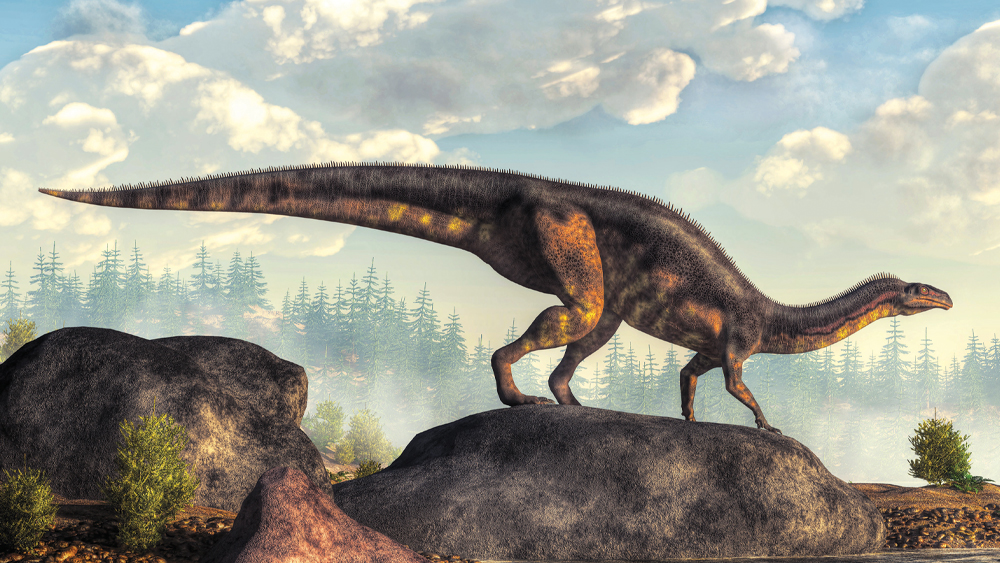A team of conventional paleontologists claims to have found the oldest dinosaur in North America, rivaling the oldest dinosaur remains found anywhere.1 Discovered in Fremont County, Wyoming, about 50 miles from Yellowstone National Park, the dinosaur was named Ahvaytum bahndooiveche, or “long ago dinosaur” in the native Shoshone language.1
“It was basically the size of a chicken but with a really long tail,” said Dr. Dave Lovelace of the University of Wyoming Geology Museum.2 The authors of the paper classified the dinosaur as a sauropodomorph, a type of long-necked dinosaur found in some of the earliest dinosaur-bearing rocks.
“Measuring just over one foot tall and three feet long, this early dinosaur likely lived an omnivorous lifestyle, similar to its sauropod relatives,” wrote Sanjana Gajbhiye.2
The isolated bones of the new species (primarily ankle and thigh bone fragments) were found in 2013 by a team from the University of Wisconsin, Madison, in the Popo Agie Formation.2 It wasn’t until recently that they determined the bones were from a new species of dinosaur. Furthermore, the age they determined for the bones, about 230 million years old (Upper Triassic), made the new dinosaur much older than any other dinosaur in Wyoming, or in North America for that matter.
In addition, the science team reported on a dinosaur-like (tridactyl) back footprint and possible front footprint found in nearby Natrona County, Wyoming, in the Jelm Formation. This unit is right below the Popo Agie Formation. The prints were found about 50 feet below the top of the Jelm Formation and estimated by the conventional scientists to be 232 million years old.1
The authors wrote, “UWGM 7435 [the footprints] represents the oldest tridactyl track referable to the Atreipus–Grallator plexus in North America and demonstrates the presence of at least one dinosauromorph [dinosaur-like] taxon prior to Popo Agie deposition.”
This discovery pushes back the claimed origins of dinosaurs in North America even further into the rock record. And other discoveries of dinosaur-like footprints in Poland push the origins of dinosaurs back to as early as 250 million years ago in conventional time.3
For years, evolutionary scientists claimed dinosaurs originated in the continents of the southern hemisphere, known as Gondwana, about 232 million years ago.3 They believed all dinosaurs in the northern hemisphere (collectively called Laurasia) migrated there many millions of years later. But now they have similar dinosaurs in both locations from about the same time. These discoveries, and the footprints in Poland, challenge their assumptions and throw the ideas about dinosaur origins into a quandary. Conventional paleontologists can’t agree on the likely ancestors of dinosaurs.3 Furthermore, many studies have shown that radioisotope dates, and their claims that involve millions of years, are also highly inaccurate.4
Flood geologists have a better explanation. They recognize that all dinosaur kinds were created in the beginning, about 6,000 years ago. There was a real global Flood about 4,500 years ago as described in Genesis. The mud and sand carried by the floodwaters buried the dinosaurs and the environments they lived in, including their bones, and preserved their footprints. So-called Triassic rocks, like the Jelm and Popo Agie Formations, represent the initial inundation of the dinosaurs and their ecosystems as waves progressed across the formerly dry land.5
ICR’s continental configuration during the deposition of these Triassic units indicates that few barriers existed between Gondwana to the south and Laurasia to the north.4 Dinosaurs are buried on multiple continents since they likely roamed freely. They didn't evolve in Gondwana and later migrate to Laurasia. They were in both locations all along.
Noah's Flood provides the best explanation for dinosaur fossils at about the same level across all of the continents.4,5 The book of Genesis reveals the origins of dinosaurs and all life on Earth. Dinosaurs didn’t appear 230-250 million years ago. They didn’t have evolutionary ancestors; they were created by the Lord Jesus. Only those who don’t accept the Bible as literal history are confused and surprised.
References
- Lovelace, D. M. et al. 2025. Rethinking Dinosaur Origins: Oldest Known Equatorial Dinosaur-Bearing Assemblage (Mid-Late Carnian Popo Agie FM, Wyoming, USA). Zoological Journal of the Linnean Society. 203 (1).
- Gajbhiye, S. North America’s Oldest Dinosaur Is Completely Rewriting History. Earth.com. Posted on earth.com January 8, 2025, accessed January 9, 2025.
- Clarey, T. 2015. Dinosaurs: Marvels of God’s Design. Green Forest, AR: Master Books.
- Clarey, T. 2020. Carved in Stone: Geological Evidence of the Worldwide Flood. Dallas, TX: Institute for Creation Research.
- Tomkins, J. 2023. The Fossils Still Say No: Paleontology of the Global Flood. Dallas, TX: Institute for Creation Research.
* Dr. Clarey is the director of research at the Institute for Creation Research and earned his doctorate in geology from Western Michigan University.






















